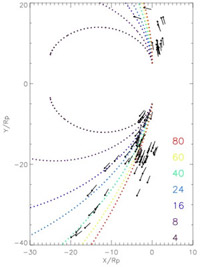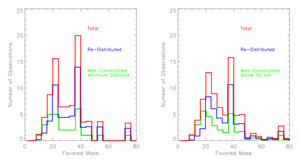2012 ARTEMIS SCIENCE NUGGETS
Lunar Pickup Ions Observed by ARTEMIS
by J. S. Halekas, UC Berkeley Space Sciences Laboratory
Introduction
The Moon, unprotected by a thick atmosphere like the Earth, is constantly bombarded by a “hailstorm” of solar wind charged particles, solar photons, and micrometeorites. These impacts release atoms from the lunar surface, with some emitted as charged ions, and others emitted in neutral form, with many of the latter subsequently ionized by photo-ionization and other processes. Once charged, these particles feel the force of electric and magnetic fields in the flowing solar wind plasma and follow huge arcing trajectories downstream from the Moon. ARTEMIS can then observe them in passing, and by precisely measuring their energy and velocity, can constrain their species and origin, thereby connecting measurements at up to 20,000 km back to the near-surface environment, and informing us about the evolution of the lunar surface and its tenuous atmosphere.
| Figure 1.The ARTEMIS probes measure fountains of ions from the Moon. |
Results
ARTEMIS regularly observes pickup ions around the Moon, at distances of up to 20,000 km from the surface. The observed ions form “fountains” with a narrow spatial and angular extent, and are generally seen in a single energy/angle bin of the ESA instrument. Since each species of ion follows a cycloidal arcing trajectory with a different characteristic gyro-radius, ARTEMIS will tend to observe ions of different species at different points in their looping trajectories, as shown in Figure 2.
| Figure 2. Trajectories for 100 plumes of pickup ions observed by ARTEMIS, compared to expected trajectories for ions of various species. |
Therefore, though ARTEMIS has no instrument with mass resolution capability, we can utilize the analytically describable characteristics of pickup ion trajectories to constrain the possible ion masses that can reach the spacecraft at the observation location in the correct energy/angle bin, allowing us to construct a “virtual mass spectrometer” from the ARTEMIS probes. Applying this technique to ~5 months of observations from the two probes, we find that most of the ARTEMIS observations are consistent with a mass range of ~20-45 amu, with a smaller fraction consistent with higher masses, and very few consistent with masses below ~15 amu. As shown in Figure 2, given the assumption that the highest fluxes of pickup ions come from near the surface, the observations favor mass ranges of ~20-24 and ~36-40 amu. These mass ranges are particularly interesting because the contain Sodium and Potassium, two species known to exist in significant quantities in both the lunar and Hermean atmospheres.
| Figure 3. The left and right panels show two different methods of reconstructing an approximate mass spectrum for the ARTEMIS observations, subject to the assumption that the largest fluxes of ions come from the lowest altitudes. |
Conclusion
Although many of the ARTEMIS observations have properties consistent with a surface or near-surface release of ions, some do not, suggesting that at least some of the observed ions have an exospheric source. Of all the proposed sources for ions and neutrals about the Moon, the pickup ion flux measured by ARTEMIS correlates best with the solar wind proton flux, indicating that sputtering plays a key role in either directly producing ions from the surface, or producing neutrals that subsequently become ionized. However, much work remains to be done before we can reach stronger conclusions as to the exact species and release mechanism.
Luckily, more ARTEMIS observations become available every day, and eventually we should have a data set large enough to split into distinct samples, to more carefully address ions with different apparent source altitudes, and ions with different apparent source mechanisms as suggested by correlation or lack thereof with various external drivers. We also anticipate making further progress by comparing with the detailed model predictions now becoming available.
Reference
Halekas, J.S., A.R. Poppe, G.T. Delory, M. Sarantos, W.M. Farrell, V. Angelopoulos, J.P. McFadden (2012), Lunar Pickup Ions Observed by ARTEMIS: Spatial and Temporal Distribution and Constraints on Species and Source Locations, J. Geophys. Res., 117, E06006, doi:10.1029/2012JE004107.Biographical Note
Jasper Halekas is an Associate Research Scientist at the U.C. Berkeley Space Sciences Laboratory. He has been studying the Moon since he was a graduate student, and is now a member of the DREAM2 SSERVI team, acting deputy PI of ARTEMIS, Guest Investigator on the LADEE mission, and a LEAG Executive Committee member. He is also currently preparing for the launch of MAVEN and starting development on the SPAN electron analyzers for the SWEAP suite on Solar Probe Plus.
 Please send comments/suggestions to
Emmanuel Masongsong / emasongsong@igpp.ucla.edu
Please send comments/suggestions to
Emmanuel Masongsong / emasongsong@igpp.ucla.edu


